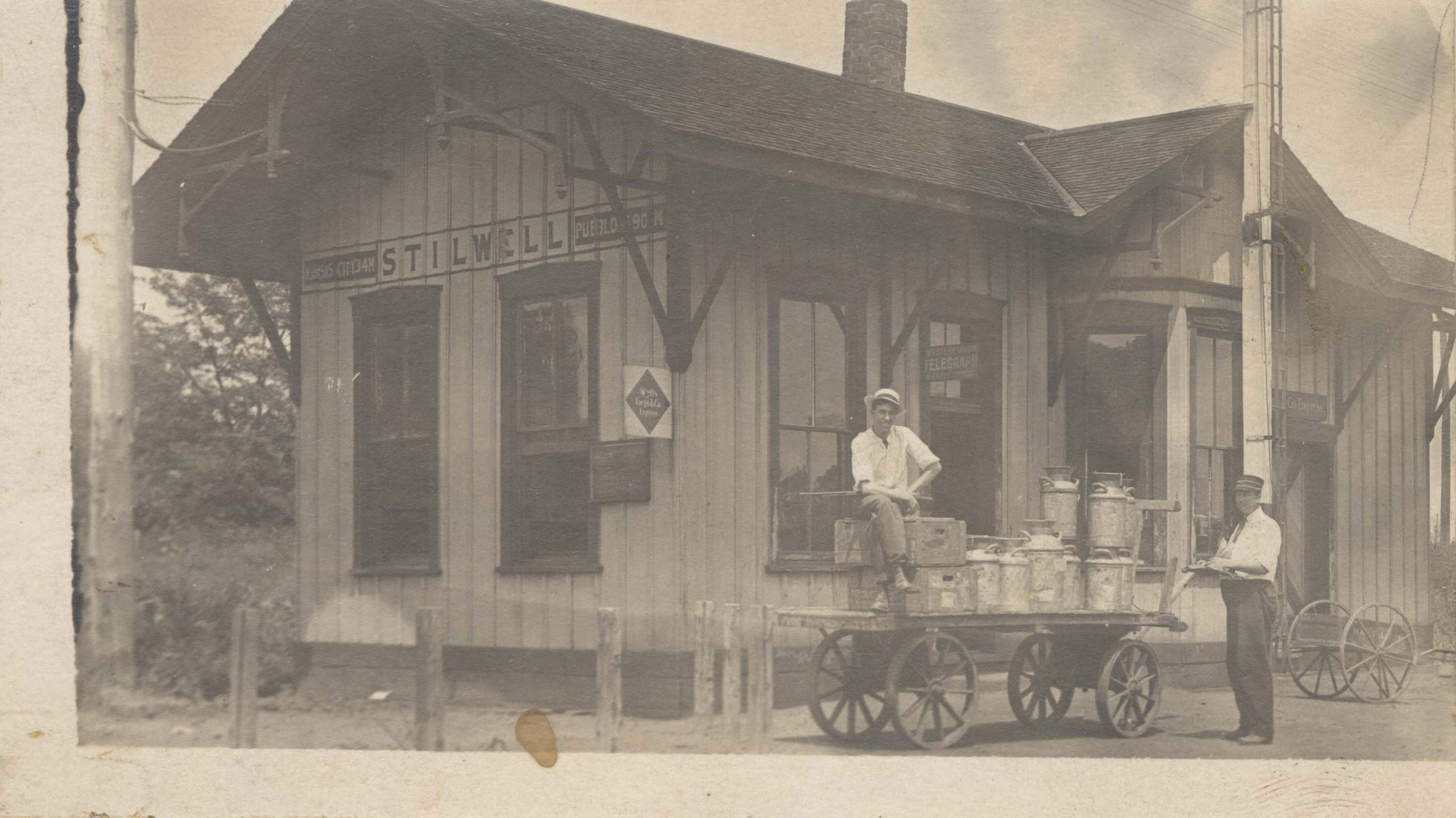Our curator of interpretation loves JoCoHistory.org so much that there is a small sign hanging outside of his cubical that reads “Have you checked JoCoHistory?” This collaborative resource dedicated to regional history is so incredible that we wanted to...
 The Johnson County Museum has digitized thousands of images from its collections that are available for viewing on JoCoHistory.org.
The Johnson County Museum has digitized thousands of images from its collections that are available for viewing on JoCoHistory.org.
Our curator of interpretation loves JoCoHistory.org so much that there is a small sign hanging outside of his cubical that reads “Have you checked JoCoHistory?” This collaborative resource dedicated to regional history is so incredible that we wanted to take a moment to share it with those of you have not yet explored the site.
JoCoHistory.org hosts the digitized collections of the Johnson County Museum and Johnson County Library, as well as partners such as the City of Lenexa, Overland Park Historical Society, Olathe Public Library, Johnson County Archives, and the Kansas School for the Deaf. On the site, the Johnson County Museum has made many of its collections accessible in digital format. Below is a list of five Museum collections available on JoCoHistory we know you’ll love!
1 Historic Photographs
The Johnson County Museum has incredible photographs in its collection, and many have been digitized and are available for viewing on JoCoHistory. On the site’s home page, users can click the Johnson County Museum heading to dive in. By then choosing “browse,” users can search by name, keyword, or date, among other categories. There are also a number of pre-arranged groupings of photos to choose from, such as portraits of men or women, farms, or carriages and buggies. Not finding what you are looking for on JoCoHistory? Reach out to the Johnson County Museum with your inquiry and we will see if we can help! Use the “contact us” function at the bottom of the site or reach out to the museum directly at: jcmuseum@jocogov.org.
 The photographs digitized on JoCoHistory.org show the incredible breadth of the Museum’s collections. This image is of an original media photo for the All-Electric House, once located in a Prairie Village neighborhood, now on display inside the Johnson County Museum today – the Museum’s largest artifact!
The photographs digitized on JoCoHistory.org show the incredible breadth of the Museum’s collections. This image is of an original media photo for the All-Electric House, once located in a Prairie Village neighborhood, now on display inside the Johnson County Museum today – the Museum’s largest artifact!
2 Historical Atlases of Johnson County
Perhaps one of the best kept secrets on JoCoHistory are the Historical Atlases of Johnson County, Kansas. These sources, dating to 1874, 1902, and 1922, include full county maps, township maps showing individual landowners, railroad routes and roads, photographs of prominent citizens, illustrations of homes and businesses, and, in the case of the 1874 Atlas, include a historical sketch of the county’s history to that date. The collection also includes the 1860 Survey Map, which was one of the first maps of what had been the Shawnee Indian Reservation from 1825 to 1854. This hand drawn and hand colored map shows land allotments granted to the Shawnee and the distance measured between geographic features.
When viewing property ownership maps in these sources, there is a trick to translating the historic map to a modern street grid. Sections – the squares with a small number in the center – are 640 acres, or 1 mile wide by 1 mile tall. The vertical section lines running north to south are the major north-south roads in the county today – Mission Road, Nall Avenue, Metcalf Avenue, Antioch Road, and so on. The horizontal section lines running east to west are the major numbered east-west streets today. There are eight numbered streets to a mile in Johnson County – in the screenshot below, “Glenn P.O.” was located at 79th Street, so the next east-west line to the south is 87th Street today, then 95th, 103rd and so on.
 This screen shot of a small portion of the 1874 Atlas Map of Johnson County, Kansas shows Shawnee Township (later divided into Shawnee and Mission Townships. Visible are roads, railroads, and sections. Within the individual township maps, landowners are also listed.
This screen shot of a small portion of the 1874 Atlas Map of Johnson County, Kansas shows Shawnee Township (later divided into Shawnee and Mission Townships. Visible are roads, railroads, and sections. Within the individual township maps, landowners are also listed.
3 Historic Preservation Survey
In the 1990s, the Johnson County Museum undertook a Historic Preservation Survey. The purpose was to document the architectural styles and conditions of more than 10,000 pre-1950 homes in the county, as well as other structures such as barns and commercial buildings. A report, available for viewing here (https://jcprd.com/DocumentCenter/View/2299/HP-Executive-Summary?bidId=), was published later, highlighting some of the more significant architectural examples. Photographs documenting the historic structures are searchable by street or keyword, or by city location. Browsing the black and white photos is a great way to learn about the historic homes in the county!
 Thousands of Johnson County’s homes were photographed as part of a preservation survey in the early 2000s. This prominent home is located in Olathe.
Thousands of Johnson County’s homes were photographed as part of a preservation survey in the early 2000s. This prominent home is located in Olathe.
4 The Squire
The Squire was a weekly Johnson County publication by editor Tom Leathers. The Museum holds a large collection of The Squire – it was broken out into the Village Squire, the Town Squire, and the Country Squire for region-specific news and advertising. The range of editions currently available on JoCoHistory is from 1961 to 1972, but later dates will be loaded onto the site in the future. Users can enjoy reading about and remembering places and events from the past or do targeted research with this incredible collection of Johnson County news!
 On JoCoHistory.org, you can browse and read hundreds of issues of The Squire, a Johnson County weekly publication from Tom Leathers.
On JoCoHistory.org, you can browse and read hundreds of issues of The Squire, a Johnson County weekly publication from Tom Leathers.
5 The Album Newsletters
Maybe researching through primary sources is not your thing – are you interested in reading about snippets of Johnson County’s history already written by professional public historians? Over the decades, the Johnson County Museum’s staff published local histories in the Museum’s quarterly newsletter, called the Album. More than 200 well-researched, easy-to-read, and illustrated episodes from the county’s past are waiting for you to explore on your down time. From Native American history to agriculture, from the advent of the automobile to suburban neighborhood development, the breadth of the county’s history available in Album articles is staggering!
 The Johnson County Museum’s past newsletters are archived on JoCoHistory.org, and include well-researched write ups on various county history topics including this one on 1950s model homes.
The Johnson County Museum’s past newsletters are archived on JoCoHistory.org, and include well-researched write ups on various county history topics including this one on 1950s model homes.
These are just a few of the ways you can engage, explore, and be entertained by Johnson County’s rich history. There are many more categories of collections from partner organizations available on JoCoHistory.org’s home page. The modern JoCoHistory Blog, with twice monthly posts from the Johnson County Museum and the Johnson County Library, are available here: https://jocohistory.wordpress.com/. At the bottom of the JoCoHistory website, you can learn more about research tools and other sources of regional and state history, as well as search accumulated results from all of the collections for specific cities and towns (and also the county’s lost communities!). Take some time this winter to explore your area’s history from the comfort of your own home – check out JoCoHistory.org. You’ll be glad you did!
If you are itching to get out of the house and explore Johnson County’s history, the Johnson County Museum is open Monday through Saturday, 9am to 4:30pm. The signature exhibit, Becoming Johnson County, the Museum’s special exhibits, and KidScape are all included in regular admission: $6 adults, $5 seniors, $4 children – Members enjoy free admission. Learn more and plan your visit at jcprd.com/Museum.











